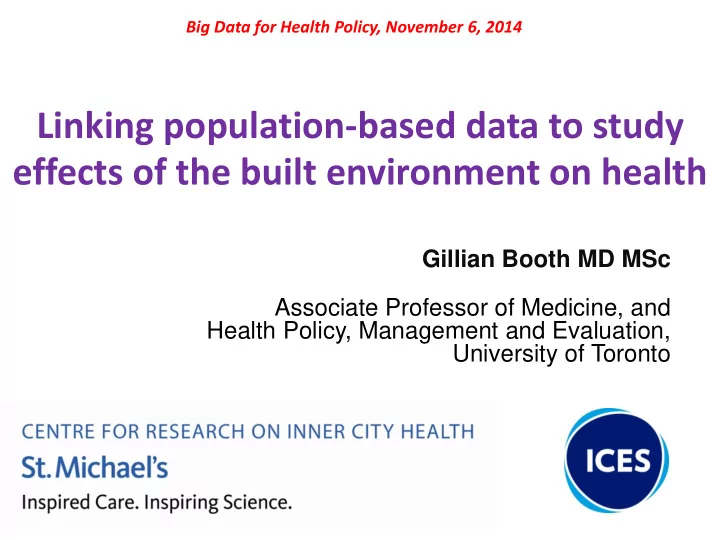

Big Data for Health Policy, November 6, 2014 Linking population-based data to study effects of the built environment on health Gillian Booth MD MSc Associate Professor of Medicine, and Health Policy, Management and Evaluation, University of Toronto
Trends in urban design car-oriented communities Compact Urban sprawl Vs. Communities
Greater reliance on automobiles
Are walkable neighborhoods experiencing a slower rise in obesity and diabetes?
Overview of methods Neighborhood Provincial health level data records + All residents aged 30-64 Walkability living in study area (community-dwelling) Postal code of residence
Study area Includes 15 municipalities , with a combined population > 7 million people Represents more than one-fifth of the Canadian population
Neighborhood exposures Walkability Index: • Population density • Residential density • Street connectivity • Walkable destinations Glazier, Creatore, Weyman, Fazli, Matheson, Gozdyra, Moineddin, Shriqui VK, Booth GL. PLoS one 2014
Results
Age-/sex-adjusted prevalence of overweight or obesity* by walkability quintile (Q) N~50,000 participants 70 across 5 CCHS cycles +13% in least walkable areas 60 50 Walkability Quintiles (Q) Percent (%) 40 - 9% in most walkable areas Q1 (least walkable) Q2 30 Q3 Q4 20 Q5 10 0 2001 2002 2003 2004 2005 2006 2007 2008 2009 Fiscal Year Data Source: Canadian Community Health Survey *adjusted for age, sex and based on ethnic-specific BMI thresholds; aged 30-64
Adjusted diabetes incidence* by walkability quintile (Q) N~3 million diabetes- 10 free residents/year 9.5 9 8.5 Q1 (least walkable) Number per 1,000 Q2 + 6% in least walkable areas 8 Q3 Q4 Q5 (most walkable) 7.5 7 - 7% in most walkable areas 6.5 6 2001 2002 2003 2004 2005 2006 2007 2008 2009 Fiscal Year Data Source: Ontario Diabetes Database, Registered Persons Database *adjusted for age, sex, income, ethnicity; aged 30-64
Mode of transportation: * Number of car trips per person per day by walkability quintile (Q) 3.00 2.50 Number of trips per capita 2.00 Q1 Q2 1.50 Q3 Q4 1.00 Q5 0.50 0.00 2001 2006 2011 Year Data Source: Transportation Tomorrow Survey *mode of transportation to work or school; aged 30-64
Mode of transportation: * Number of public transit trips per person per day by walkability quintile (Q) 0.70 0.60 Number of trips per capita 0.50 Q1 0.40 Q2 Q3 0.30 Q4 Q5 0.20 0.10 0.00 2001 2006 2011 Year Data Source: Transportation Tomorrow Survey *mode of transportation to work or school; aged 30-64
Mode of transportation: * Number of walking/cycling trips per person per day by walkability quintile (Q) 0.30 0.25 Number of trips per capita 0.20 Q1 Q2 0.15 Q3 Q4 0.10 Q5 0.05 0.00 2001 2006 2011 Year Data Source: Transportation Tomorrow Survey *mode of transportation to work or school; aged 30-64
Other lifestyle characteristics* by walkability quintile (Q) Inadequate fruit and vegetable ‘Inactive’ leisure time intake 0.7 0.7 0.65 0.65 0.6 0.6 Walkability Quintile 0.55 0.55 Proportion Proportion Q1 0.5 0.5 Q2 0.45 0.45 Q3 0.4 0.4 Q4 Q5 0.35 0.35 0.3 0.3 0.25 0.25 0.2 0.2 2003 2004 2005 2006 2007 2008 2009 2003 2004 2005 2006 2007 2008 2009 Year Year Data Source: Canadian Community Health Survey *adjusted for age and sex; aged 30-64
Are individuals living in more walkable areas at lower risk of developing diabetes?
Creation of study cohort Provincial health databases Lowest walkability Highest walkability quintile = 466,957 quintile = 491,610 using postal code on April 1, 2002 Excluding • prior diagnosis of diabetes • living in long-term care facilities or other institutions March 31, 2012 for the development of diabetes (Ontario Diabetes Database)
Inverse Probability Treatment Weighting (IPTW) to create balanced groups propensity scores reflecting the likelihood of living in the highest vs. lowest walkability area weights were assigned to each individual based on their propensity score 5 region-specific Cox P.H. models - Toronto - Greater Toronto Area - Ottawa - Hamilton - London Random effects to generate summary HRs
Baseline characteristics after IPTW weights Characteristic Low High Standardized differences walkability walkability Mean age 48.4 48.6 0.009 % Males 48.5 48.6 0.003 % Recent immigrants 7.1 6.3 0.03 % South Asian 5.4 5.6 0.01 % Other visible minority 20.1 19.2 0.03 % Highest deprivation quintile 15.7 12.6 0.09 Mean no. primary care visits/year 4.66 4.64 0.003 % Unstable chronic disease 24.8 24.7 0.001 % Myocardial infarction 0.7 0.7 0.001 Standardized difference < 0.1 = well balanced groups
Diabetes incidence in highest vs. lowest walkability quintile among individuals age 30-64 yrs Toronto Greater Toronto Area Ottawa Hamilton London Summary Overall HR 0.85 Hazard Ratio Favours high walkability Based on weights from IPTW; * includes age, sex, income, % visible minority, % South Asians baseline comorbidity, hypertension, cardiovascular disease (MI, stroke)
Diabetes incidence in highest vs. lowest walkability quintile, all analyses, aged 30-64 Recent immigrants Long-term residents Low income High income Summary Overall HR 0.85 Adjusted Hazard Ratio
Conclusions • High neighborhood walkability appears to be protective for the development of diabetes in young and middle-aged urban populations • Changes in zoning, urban planning, and design that promote walking and other forms of active transportation may help to curb the ongoing rise in obesity and diabetes. Further research is needed to understand the full • impact that such interventions will have.
Recommend
More recommend